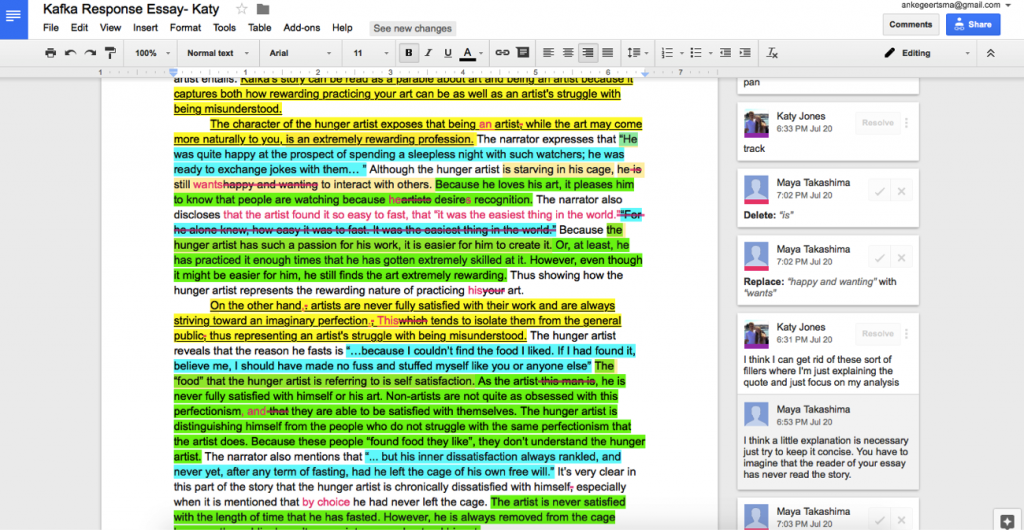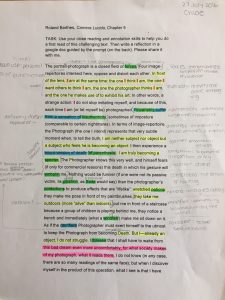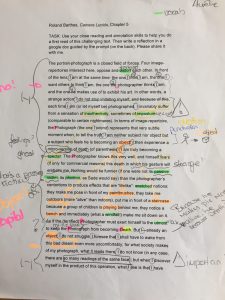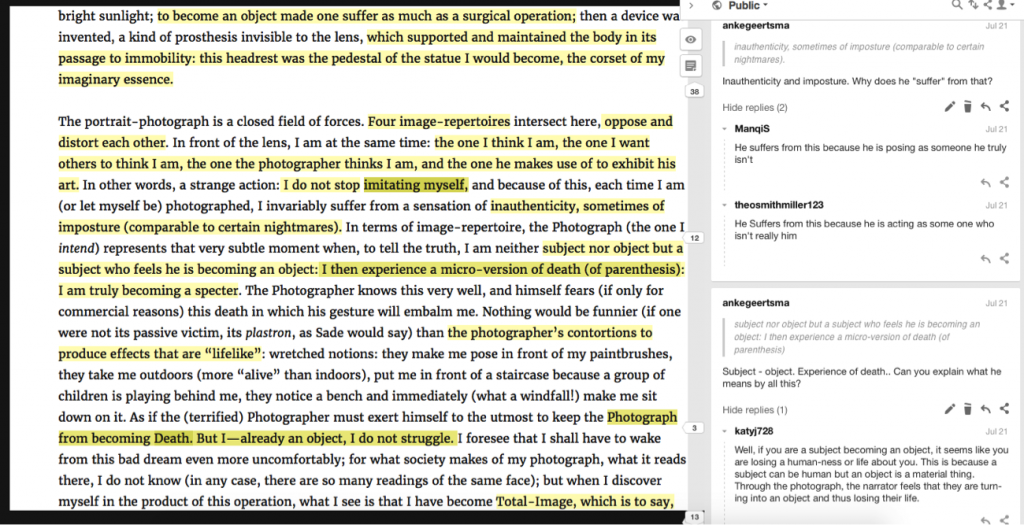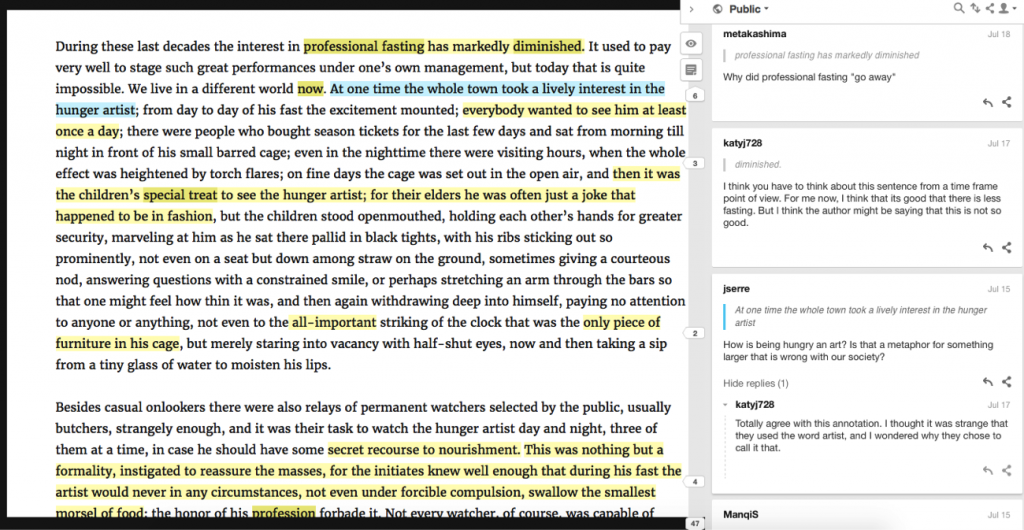After having taught a fully online summer course at The Cooper Union (see previous post), I want to use those course evaluations to develop some takeaways for my course design at Baruch College. I’ll be teaching a hybrid Great Works of Literature I course here in Fall 2017, and want to use what I’ve learned this past summer while also keeping in mind the differences between an online college-prep writing class at a private institution vs. a college literature class at a public university like CUNY’s Baruch College.
So, while my course evaluations from this past summer will give me some useful takeaways, I want to keep in mind the following differences when designing the hybrid course for Baruch’s Great Works program:
| Baruch Great Works Course | The Cooper Union Summer Writing Program |
| Hybrid (meets F2F 1:40 hrs a week) | Online (with 2 hrs a day meeting on Google Hangouts) |
| College | College-prep |
| Public College (serving largely minority and low-income student population) | Private Institution (for-profit course) |
| Semester-long (15 weeks) | 3 week summer course |
| Student assessment | No student assessment |
| Credit-bearing | Not credit-bearing |
| Literature (but “communication intensive”) | Reading and Writing skills |
With these differences in mind, I want to ask myself the following questions while designing the Baruch course:
- How do I give sufficient guidance and practice in annotation, especially for students who have not yet developed this habit or have never received instruction? (maybe in previous courses/high school it was considered “intuitive,” i.e. not in need of instruction)
- How do I create awareness of the social aspect of online annotation and the more public-facing nature of it?
- How do I address audience and what makes a “productive utterance,” and to what extent do I ask them to reduce their annotations to these kind of utterances? Aren’t they allowed to say whatever they want? Isn’t a feeling or emotional response to a text also a “productive utterance”?
- How do I create alternative but similar assignments or build in some redundancy to make up for the fact that the online annotation happens in a predetermined space (with little room for more “creative” annotation)?
- How do I deal with students who might have limited access to a computer and who might therefore have limited time to read the texts online?
- How do I discuss privacy concerns online, especially since annotating and blogging online means that students will publish in-progress work and vague thoughts or incomplete responses to readings?
- How do I bridge what we do online, especially the annotations, with the F2F activities and discussion? How do I make sure we can continue the conversation?
- How to assess online annotation, especially the “social” part where students comment on each other’s comments and blog posts?
I think I can address the first three points, about guidance and practice, the public-facing and social aspect of online annotation, and the discussion around “productive utterances,” by building in an assignment and discussion early on in the course that will bring out these issues. I am thinking of doing an analogue annotation exercise in one of the first classes, with just a print-out of a short story or poem, preceded by a short discussion on what annotation is. Since the Baruch course is a literature course, I can mention that writers such as Montaigne, Coleridge and Blake practised annotation extensively and that it was an essential part of pedagogy in the universities of Renaissance France and England. Overall, the circulation of texts with footnotes and other “marginalia,” as Coleridge called it, was immensely popular in the eighteenth century. I plan to bring in Sam Anderson’s article that shows how annotation was a very social practice, and that for a long time readers have been annotating books for their friends and marking up novels for their potential lovers–a world of sharing that is not so dissimilar from how we interact online now ourselves.
Giving a brief overview of the history of annotation will not only fulfill some of the content goals of the course but also give students a sense of how their work fits in the trajectory of literary scholarship and reading in general. In the discussion surrounding their analogue annotation exercise, I can furthermore ask them to reflect on how they annotate and what kind of annotations they use. I plan to ask students to share their annotations in pairs or small group to compare and discuss if reading others’ annotations is useful for them. This can lead into a discussion on what kinds of annotations are “productive” to others and if that means we should restrict ourselves to those when we move to the online space.
A follow-up exercise to the analogue annotation would be to move to the site to annotate online for the first time. I will post and discuss guidelines on how to sign up for Hypothes.is and show the tool in class. I will ask students to practice annotating a short text after which we can have another discussion, or low-stakes writing reflection, on the difference between the two forms. Hopefully this will bring up the issue of audience and the “productive utterance” again, as well as what they now think is their preferred reading strategy. I want students to become more self-aware of how they want to read and annotate online before we just “assume” the use of this tool. Even if they shift their strategy later on, I want them to think about when they annotate (read whole text first? read other annotations later?), and how they want to deal with the “chorus of voices” they will encounter while reading, especially since one of the downsides of these tools, according to the research done so far, is that annotations can be distracting to students.
Question number four, on creating similar assignments or building in redundancy to compensate for the lack of “creative” annotation in these online tools, I hope to address by continuing to do in-class annotation or other close reading exercises, and by combining it with more creative responding to our readings. By this I mean that students can imitate or write their contemporary version of a text or complete an assignment that asks them to “translate” a written text into a different medium, such as audio, photo, or video. This would be a productive exercise for a hybrid course like this, since they can then share their multimedia work on the site.
I plan to address questions five and six, on access and privacy, by sharing information on the role of data in for example the recent election, and by asking students to do some of their own research on data and online privacy. I want to spend one session on this issue, asking students to gather some information online that they can write a short response to for on the blog. Ideally, by starting the semester aware of these concerns, students will be able to see how these issues relate not just to their posting on a course blog but to their entire online lives. Also, if it does not happen naturally, I will guide this more general discussion on privacy to more specific questions on posting “vague” and incomplete writing in annotations and on the blog and what that means for their online presence.
Concerning student access to a computer, I want to include a question in the questionnaire that I give to all students at the start of the semester on whether they foresee any issues with this. I will point out that most of the reading will happen on the site, but that I can make texts available in PDF format if necessary. I will check in at several points during the semester to make sure students are still able to read online. Of course, I will point out right at the beginning that, since it is a hybrid course, a lot of work will be online, but that it is possible to transfer to a F2F class if needed.
The last two questions concern bridging the online and the F2F and assessment. These concerns not only have to do with annotation but with teaching online or hybrid classes in general. Still, the sheer amount of student annotations (my class will have around 25 students) and the social aspect will cause some difficulties when it comes to taking online discussion into the F2F classroom. How do I make sure students don’t “forget” what they say in their annotations? How do I continue the “momentum” of the online discussion, especially when I see students responding to each other’s comments? Do I want to bring the online discussion to our F2F class every time or is that a better place for other activities? As far as assessment goes, I am mostly concerned with how to make sure students participate online and how to give recognition to what they do there. I cannot record all online activity, so what place do I give annotation in the course’s assessment structure?
One way to bridge the gap between the online and F2F class is to ask student to write down and bring to class three (or more or less) annotations they made, or three that another student made and they thought were useful, confusing, or a good starting point for a discussion. Another strategy I can use for guided annotation (where I write questions in the margins before students read the text) is to go over those questions and students’ answers in class. Ideally, I can pull up the screen in class to do this. I can also make a small group of students responsible for that day’s discussion by asking them to pick some annotations or summarize what was said online. They can then also lead discussion. Overall, I want to avoid rehashing what was done online and make sure we move on to a next level of responding and thinking about the readings. Other activities, such as writing short reflections or responding to the questions asked in the annotations, and developing positions on the readings are more relevant for in-class work.
Finally, on assessment, I want to create an assessment structure that does not include direct recognition of the online annotating itself (as that is virtually impossible) but which values work that necessitates that students annotate and use the insights from doing so. In short, I have to make sure I make annotation an essential step in the scaffolding of my larger assignments. I can still include one close reading response early on in the class where the link between annotating and assessment is more direct (since it is a close reading response, the annotations will directly feed into the response paper), but later assignments will in less direct ways include annotation as part of the assessment structure. Also, I am planning to assign more targeted annotation exercises to groups. When I ask one group to annotate for context, another for vocabulary, and another for rhetoric and argument, the social and collaborative aspect of the annotation tools will come to the fore more clearly. For them, and for me, to be able to track their work, I can ask each group to make a plan with tasks for each group member, and a log which tracks whether everyone did their part.
The next step for me is to translate all these thoughts and takeaways into a clear course structure and concrete assignments. As the Baruch course has more students and runs longer, the next set of course evaluations and my own reflections will hopefully yield even more insight into how best to use online annotations in the classroom. So this project is still on-going, and I plan to share all course materials for the Baruch course here soon. At the end of the semester, I’ll post a summary of the course evaluations with my own reflections, and as always, I invite comments (using hypothes.is or the comment section below) from others instructors working with online annotation tools on this project. This way I hope to continue the conversation on new ways to read and write online in the higher ed classroom.

